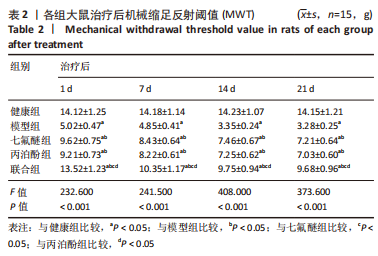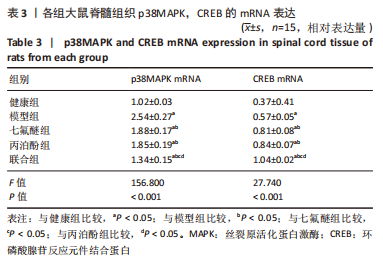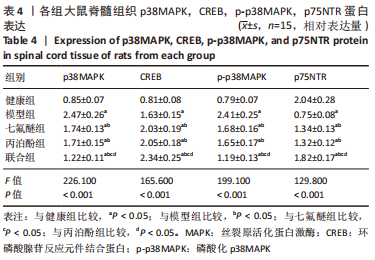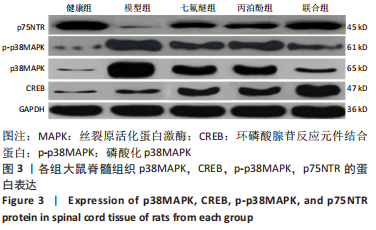[1] 刘璐,许涛,李冰冰,等.经颅直流电刺激治疗脊髓损伤后神经病理性疼痛的疗效观察[J].中华物理医学与康复杂志,2020,42(8):721-723.
[2] 苏盈笑,徐国海.病理性神经痛与P38MAPK信号通路关系的研究进展[J].江西医药,2018,53(2):170-172.
[3] 王晓庆. IL-17A/CaMKⅡ/CREB信号通路在青藤碱治疗神经病理性疼痛中的机制研究[D].兰州:兰州大学,2021.
[4] 周晔,吴巧云,屠文展,等.电针对神经病理性疼痛大鼠损伤处脊髓背角形态及p38MAPK蛋白表达的影响[J].针刺研究,2020,45(5):368-372+378.
[5] 王迪,王德军,魏庆双,等.电针治疗脊髓损伤抗凋亡机制的研究进展[J].针灸临床杂志,2019,35(3):74-76.
[6] JECROIS ES, ZHENG W, BORNHORST M, et al. Treatment during a developmental window prevents NF1-associated optic pathway gliomas by targeting Erk-dependent migrating glial progenitors. Dev Cell. 2021; 56(20):2871-2885.
[7] ZHAO D, ZHANG M, YANG L,et al. GPR68 Improves Nerve Damage and Myelination in an Immature Rat Model Induced by Sevoflurane Anesthesia by Activating cAMP/CREB to Mediate BDNF. ACS Chem Neurosci. 2022;13(3): 423-431.
[8] 肖纯,孙建良,卢波,等.大鼠背根神经节ERK5/CREB信号通路在神经病理性疼痛中的作用[J].浙江中西医结合杂志,2013,23(3):179-183.
[9] 郝建红,何非,吴赞情,等.异丙酚对急性脊髓损伤大鼠神经元凋亡的影响[J].山西医科大学学报,2019,50(8):1128-1133.
[10] 巩超,张小霓,李士通.七氟醚对高位脊髓损伤大鼠心肌钙敏感受体表达的影响[J].中华麻醉学杂志,2015,35(7):879-882.
[11] 倪梦雅,陈潇潇,倪文宗.七氟醚复合丙泊酚麻醉对MCI大鼠胫骨骨折术后认知功能的影响及机制[J].临床和实验医学杂志,2020,19(9):935-939.
[12] 曹俊浩,刘建伟.丙泊酚与七氟醚对肝炎肝硬化围术期凝血功能的影响[J].血栓与止血学,2022,28(2):302-303.
[13] 汪文刚,林毅,沈翔.七氟醚复合丙泊酚静吸复合麻醉对老年妇科肿瘤患者术后认知功能和血流动力学的影响[J].解放军医药杂志,2019,31(9): 104-107.
[14] 黄贻泽,彭琳,张戈.硫酸软骨素酶ABC联合脊髓康对大鼠脊柱脊髓损伤后的神经功能恢复、TGF-β1、HIF-1α、Nogo-NgR信号通路的影响[J].海南医学院学报,2019,25(2):94-98.
[15] 左薇,穆敬平,许明军.夹脊穴电针对实验性脊髓损伤后中枢性疼痛模型大鼠自发痛行为学和痛超敏现象的影响[J].中国医药导报,2021, 18(27):17-20.
[16] CHENG F, QIN W, YANG AX, et al. Propofol alleviates neuropathic pain in chronic constriction injury rat models via the microRNA-140-3p/Jagged-1 peptide/Notch signaling pathway. Synapse. 2021;75(10):22219.
[17] Chen Z, Ding Y, Zeng Y, et al. Dexmedetomidine reduces propofol-induced hippocampal neuron injury by modulating the miR-377-5p/Arc pathway. BMC Pharmacol Toxicol. 2022;23(1):18.
[18] 江杭. p75NTR基因敲除小鼠的疼痛敏感性评估[D].济南:山东大学, 2019.
[19] 邓亚军. PKA通过p38MAPK通路介导脊髓细胞凋亡参与神经病理性疼痛的研究[D].兰州:兰州大学,2020.
[20] 徐良,裘涛,张丽娟,等.慢性压迫损伤性神经病理性疼痛大鼠模型中脊髓背角ERK、CREB、BDNF表达的变化[J].浙江医学,2016,38(16): 1341-1344.
[21] 张弘来,高飞,陈霄雷,等.丙泊酚通过调节脊柱GluN2B-p38 MAPK/EPAC1通路减轻慢性收缩损伤引起的神经性疼痛的大鼠模型研究[J].临床和实验医学杂志,2021,20(3):237-241.
[22] 刘波,张利佳,郭宇峰,等.七氟醚麻醉对大鼠认知功能、神经细胞凋亡及MAPK信号通路的影响[J].中国组织化学与细胞化学杂志,2020, 29(6):514-518.
[23] 张家玮,孙嘉锴,郑峤,等.810 nm弱激光对脊髓损伤小鼠神经元轴类再生的促进作用及其相关机制[J].中华创伤杂志,2019,35(4):359-367.
[24] 卢远征,李恒杰,魏红艳,等. 心肺复苏后吸入七氟醚通过调控Bcl-2/Bax减少神经元凋亡[J]. 中国急救医学,2018,38(4):357-362.
[25] 魏海婷,任峰,刘琳琳,等.TLR4-p38MAPK-NF-κB信号通路在七氟醚降低老龄大鼠认知功能中的作用[J].中华麻醉学杂志,2019,39(5):561-564.
[26] 杜天平,孟祖东.17β雌二醇对异丙酚诱导发育期大鼠海马神经细胞凋亡时p38MAPK信号传导通路的作用机制[J].中国临床药理学与治疗学, 2019,24(2):128-133.
|











